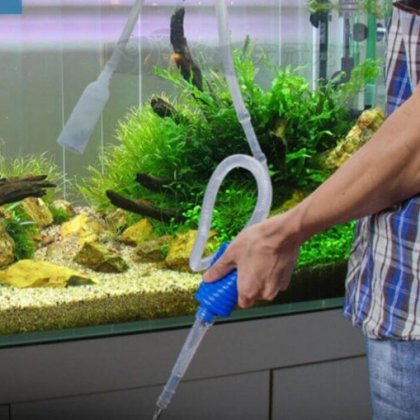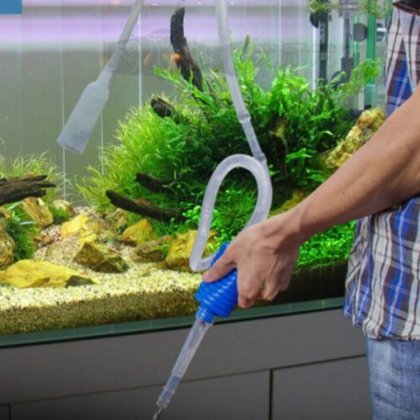Red Turquoise Discus Aquarium Care, Feeding and Native Habitat Information
Red Turquoise Discus originate from the Amazon River Systems of South America, where they were first imported into the aquarium hobby in the early 1930s. Ever since their introduction into the hobby to this day, Discus are considered one of the most colorful, demanding, rewarding and expensive of all tropical freshwater aquarium fish species. Due to their popularity and the high price tag that they command, Discus are very popular with fish breeders. Over the years breeders have not only raised enough tank-bred specimens to largely fulfill the demand from the aquarium hobby, but have developed completely new color strains and patterns as well. Discus are very popular amongst intermediate to advanced fish keepers, and are widely considered to be one of the most rewarding and challenging to keep of the freshwater tropical community fish species available within the hobby.
In the wild, Red Turquoise Discus are found living in the upper tributaries of the Rio Negro and Rio Madiera along with the surrounding lakes and flood plains. The water is very low in mineral content, which makes it "soft" water with a low pH ranging from 4.0 to 7.0. The water also maintains very stable and consistent water parameters year round, including water temperatures that range between 80 to 86 degrees Fahrenheit both during the day and night. When keeping Red Turquoise Discus in the home aquarium, it is extremely important to replicate their natural surroundings and water parameters as closely as possible. It is also very important to maintain very consistent water parameters that have very little pH, temperature and dissolved mineral fluctuations.
Red Turquoise Discus aquariums should closely resemble their natural Amazonian habitat with plenty of plants and branching root. Water parameters should be very consistent with a pH near 6.8 to 7.2, temperature between 82° to 86° Fahrenheit with low to medium water currents. Discus can thrive in a wider range of water parameters as long as the changes are not sudden and the fish has adequate time to adjust to changing parameters. Red Turquoise Discus should not be housed with aggressive or boisterous fish species or in aquariums with intense lighting or strong water currents. If strong aquarium lighting is used for plant growth, be sure that the density of the plant life is great enough to provide shaded areas for the Red Turquoise Discus to retreat to when needed. Strong biological and mechanical filtration along with weekly partial water changes are required to keep water quality high and water parameters consistent. When keeping Discus with live plants, it is best to keep the aquarium pH between 6.0 to 6.8 and a lower water hardness of 150 PPM or less. Lastly, be sure to maintain excellent water quality at all times as Discus do not leave a lot of room for error when it comes to water quality and consistency. Recommended tank mates include: most Tetra species, loaches, cory catfish, smaller Plecostomus species, Siamese Algae Eaters, Ottocinclus, Rams, peaceful Rasbora species, Rainbow fish, Hatchet fish and Pencilfish.
Being closely related to the freshwater Amazonian Angelfish, it was assumed that Discus breeding requirements would be the same. Early hobbyists removed the eggs, attempted to hatch them in a separate tank and grow the fry on. We now know this is not possible with Discus because fry consume the mucus excreted from the sides of the parents. Discus were not successfully spawned until the late fifties with Jack Wattley in America and Eduard Schmidt-Focke in Germany doing the pioneering work.
During the 1970s breeders began to concentrate on producing more colorful Discus with a broader range of colors and patterns. They selectively bred specimens for their blue striations that eventually produced Turquoise and Cobalt Discus, while other breeders intensified the natural red striations that later produced Red Turquoise Discus and Pigeon Blood Discus. The 1980s and 1990s saw an explosion in new Discus mutations with the development of the Ghost, Snake Skin, Pigeon Blood, Blue Diamond, Snow White and Albino Discus variations. Through selective breeding, todays aquarium hobbyists can choose from a wide variety of brightly colored and varied patterned Discus now available within the hobby.
Red Turquoise Discus should be fed a variety of nutritional meaty foods including: white worms, blood worms, Tubifex worms, high protein pellet and flake foods. Juvenile Red Turquoise Discus should be fed at least 3 to 5 times per day, while adult specimens should be fed 2 to 3 times per day. Their overall diet should be higher in proteins and fats then the average tropical fish species. As with most other fish species, they should be fed an amount of food that they will consume within 10 minutes, with leftover foods removed from the system by either a quality mechanical filter or manually if strong filtration is not present.
No reviews found!





























































No comments found for this product. Be the first to comment!